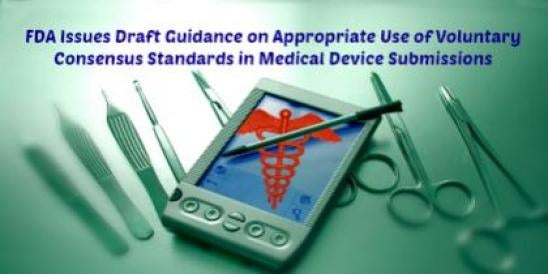The FDA recently released a draft guidance document titled “Appropriate Use of Voluntary Consensus Standards in Premarket Submissions for Medical Devices.” A manufacturer can rely on voluntary consensus standards to satisfy safety and effective requirements, among others, for a premarket submission.
The draft guidance touts several benefits to FDA and industry of voluntary consensus standards: “The use of consensus standards can increase predictability, streamline premarket review, provide clearer regulatory expectations and facilitate market entry for safe and effective medical products. Consensus standards provide a consensus approach to certain aspects of the evaluation of device safety and effectiveness, such as testing methods, pass/fail performance criteria, and processes to address areas, such as risk management and usability. The use of consensus standards can also promote international harmonization.”
Among other things, the draft guidance discusses both appropriate and inappropriate uses of voluntary consensus standards. According to the draft guidance, there are two appropriate uses of consensus standards in the premarket process. First, “a Declaration of Conformity to an FDA-recognized consensus standard can be used when a submitter certifies that its device conforms to all of the requirements of an FDA-recognized consensus standard except for inapplicable requirements.” Second, “general use of a consensus standard in premarket submissions refers to situations where a submitter chooses to conform to a consensus standard, in part or in whole, but does not submit a Declaration of Conformity.” A Declaration of Conformity may not be used if the submitter chooses to rely on a consensus standard that FDA does not recognize or if the submitter has deviated from an FDA-recognized consensus standard. The draft guidance also notes that “some FDA-recognized consensus standards … are too general and broad in scope for FDA to determine whether conformance to the applicable consensus standard has been met unless FDA also reviews the underlying data.” In such cases, a submission which relies on the standard but does not include the underlying data is likely to lead to a request for additional information.
Reasons for general use of a consensus standard include: (1) the manufacturer has used a non-recognized consensus standard (e.g., because there is no FDA-recognized consensus standard applicable to the device type); or (2) the manufacturer has made changes to the FDA-recognized consensus standard methodology to adopt its purpose to test the device.
Examples of inappropriate uses include using a version of a consensus standard that FDA does not recognize, or not realizing that only certain aspects of a particular consensus standard have been recognized by FDA. It is also inappropriate to use consensus standards that do not apply to the particular type of device or testing performed. When submitters do not use consensus standards appropriately, FDA’s review staff must often request additional information to address the issue(s) the standard was intended to address. Of course, this translates into additional delay and expense.
A pdf copy of the draft guidance is available here.


 i
i

